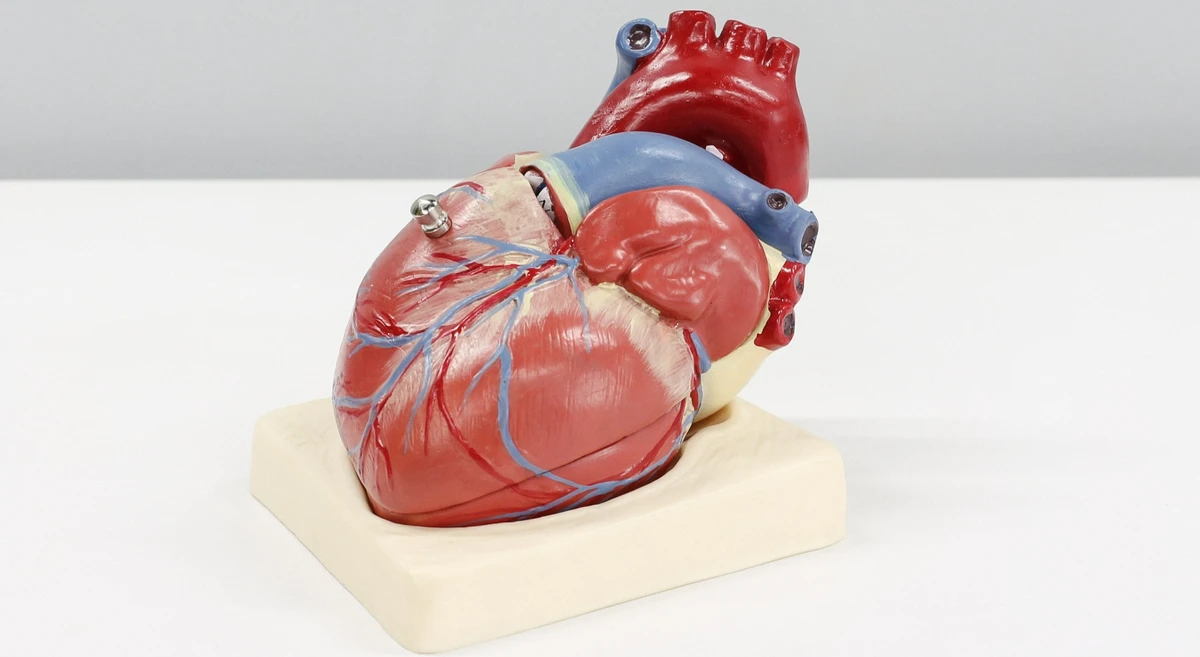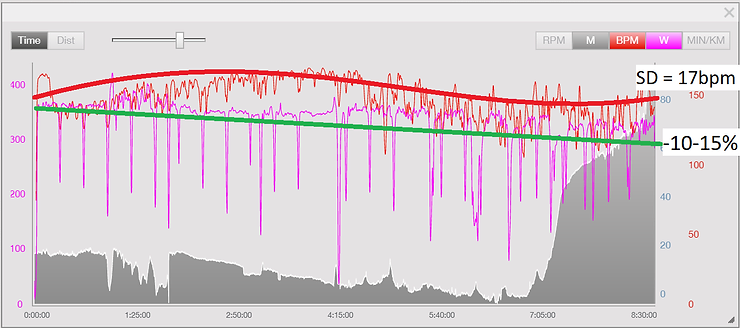“Despite the increased ease of heart rate measurement through the development of wrist-based sensors, many athletes and coaches have moved away from heart-rate-based training.”
- Cardiovascular vs Metabolic
- Cardiovascular vs Mechanical
- Pacing at the start of a race (short or long)
- Training load for intervals
- Reliability with wrist-based heart rate
Heart Rate Defined.
The term “heart rate” describes the frequency (in beats per minute) at which the heart is beating at a given point in time. Combined with the stroke volume (the amount of blood ejected from the heart per beat) it determines the total quantity of blood being pumped from the heart to circulate around the body per minute (the cardiac output). Blood carries oxygen and fuel to the muscles and removes carbon dioxide as a waste product. At rest, our need for this process is low, so the heart can beat relatively slowly to fulfill requirements. However, during exercise, the demand for blood increases dramatically, and, as the ability for stroke rate to increase is low, this is primarily met by increasing heart rate, making heart rate a good indicator of how hard the body is working to produce energy. Consequently, heart rate has been used by athletes and coaches for several decades to objectively measure exercise intensity and prescribe training.
However, despite its advantage over earlier training metrics, such as perceived exertion, heart rate is not a perfect training tool. In fact, despite the increased ease of heart rate measurement through the development of wrist-based sensors, many athletes and coaches have moved away from heart-rate-based training in recent years with the rise of alternative training devices, such as running power meters.
Following this trend, we outline five reasons why heart rate shouldn’t be your key training metric.
First, a recap of some important terms:
- Heart rate (bpm). The number of heartbeats per minute.
- Stroke Volume (Liters). The volume of blood pumped out of the heart per beat.
- Cardiac output (L/min). The volume of blood pumped out of the heart per minute.
- Cardiac output (CO) = Heart Rate (HR) x Stroke Volume (SV)
Reason #1 .
Cardiac drift leads to an increase in heart rate during steady-state exercise
When exercising at a constant intensity, your heart rate will increase gradually over time, even while your level of effort remains the same. This is known as cardiac output and it is coupled with a progressive decline in stroke volume and the continued maintenance of cardiac output.
Cardiac drift during exercise is driven by an increase in core temperature and the loss of water from the body.. When core temperature increases, the body responds by increasing blood flow to the skin in an effort to control the temperature rise by releasing heat through processes such as sweating. However, this increase in skin blood flow occurs concurrently with the huge increase in demand for blood flow by the working muscles, leading to competition for blood flow from different parts of the body. In addition to this, the release of heat through sweat also causes a drop in blood volume through water loss. A drop in blood volume leads to a reduction in stroke volume. To maintain cardiac output and meet the demands of the working muscles, heart rate must increase to compensate for the reduction in stroke volume. This is what drives cardiac drift.
CO ↔= ⬆HR x ⬇SV
The concept of cardiac drift shows the downside of using a heart rate to monitor a steady-state effort. Your heart rate may undergo cardiac drift, moving you from one zone to the next without any change in the mechanical work rate of your muscles, i.e., pace or power output.
Reason #2.
The O2 slow component leads to an increase in heart rate during constant-work-rate exercise performed at intensities above the lactate threshold.
Like cardiac drift, the O₂ slow component refers to a slowly developing increase in VO₂. However, rather than taking place during steady state exercise, it operates when constant-work-rate exercise is performed above the lactate threshold. The O2 slow component represents a progressive loss of skeletal muscle contractile efficiency and is associated with the fatigue process.
There is strong evidence that, during constant-work-rate exercise, development of the O₂ slow component is associated with the progressive recruitment of type II muscle fibres which are presumed to be less efficient than the larger type I muscle fibres that primarily drive exercise at low intensities. (REF, REF). For the cardiovascular system to supply the working muscles with more O2 to meet the increased fuel needs of these muscle fibres, cardiac output must increase.
⬆CO = ⬆HR x ↔SV
Therefore, as with cardiac drift, the occurrence of the O2 slow component means that during constant rate exercise above the lactate threshold, heart rate will increase gradually without altering mechanical output. However, in contrast to cardiac drift, where cardiac output is maintained through an increase in heart rate and metabolic and mechanical requirements can be similar despite this increase, the O2 slow component is associated with increased metabolic demand (losses of contractile activity and O2 economy). This means that while heart rate reflects the metabolic demands of the working muscle, it does not provide insight into how much force you are producing. For example, in a steady-state effort like a marathon or TT, to achieve your desired time, you need to hold a consistent force output in the face of fatigue. By monitoring your effort via heart rate, you will not know when your force is dropping. Only a power meter will give you this information.
Reason #3.
The change in heart rate at exercise onset lags behind the increase in intensity.
At the onset of exercise, there is a delay between the increases in oxygen and fuel usage by the working muscles and the delivery of blood to the muscles to meet these requirements. The initial O2 demand can be buffered by myoglobin, a storage form of oxygen found in the muscles, but when exercise at heavy to severe intensities is continued for more than 30 s, increases in blood flow and O2 extraction must occur. Overlay this process with the increases in core body temperature and fluid loss during exercise and their consequent effects on heart rate and you’re beginning to get a very noisy picture if heart rate is used alone to predict exercise intensity..
Think about a run session involving 3 min intervals at lactate threshold. At the start of each interval, as effort is increased, it takes a while before heart rate “catches up” to the intensity of the mechanical effort being put out by the muscles. However, in order to make their watch show the prescribed heart rate, athletes tend to run faster than the intensity prescribed to get their heart rate into the required zone more quickly. This leads to them overshooting the heart rate zone and subsequently decreasing their effort to get back to the prescribed level. Therefore, rather than a constant rate effort at lactate threshold, what results is a mix of intensities below and above the intended level.
Reason #4.
The heart rate lag at the onset of exercise can affect pacing
The lag in heart rate change described in the previous point can impact pacing. Controlling energy usage at the beginning of a race by not going out “too hard” is paramount to race success (see podcast and webinar). Thus, the excessive metabolic and mechanical work rates that may occur if heart rate is used to select pace prior to the heart rate lag may be detrimental to the achievement of optimal performance. Even in retrospective analysis it may be difficult to determine how “hard” you were going at the start of the race if your heart rate was low for the first 10 min. On the other hand, an elevation in heart rate due to nerves or caffeine use may cause you to under pace your effort for longer duration races such as marathons and ultramarathons.
Reason #5.
The reliability of wrist-based heart rate monitors is low
Optical heart rate monitors use light to measure tissue changes at the sensor caused by blood circulating throughout the body. High blood volumes, which occur when the heart beats, cause less light to return to the optical sensor, whereas the low volumes between beats are associated with an increased amount of returning light. Measuring the time between high- and low-light intensities enables these devices to measure beat-to-beat time intervals and thereby calculate heart rate. The signal that the device measures with the optical sensor is called a photoplethysmograph (PPG).
A major issue with the use of these sensors on watches is interference with the PPG signals due to movement. To overcome this problem, a 3D acceleration sensor is incorporated within the watch. Measuring acceleration and optical signals together enables differentiation between volumetric changes caused by the pumping heart to those caused by movement of the hand. Additionally, as watch technology has advanced, more LEDs have been added to these devices to provide more optical light paths to the detector. When the signals from each LED are sufficiently similar, the algorithm within the watch can conclude that they originate from the pumping heart and not from hand movements. The use of coloured LEDs, which have longer wavelengths that penetrate the skin deeper, also give more accurate readings — especially when the skin is cold.
Despite these modifications, the accuracy of the data produced by wrist-based monitors can vary across brands based on activity patterns or speed, exercise intensities, skin tone, temperature, placement of sensors, or compression-induced and motion-induced artifacts. Thus, relying on heart rate measurements produced by wrist-based heart rate monitors can be risky.
Conclusion
Heart rate is a useful training metric, but, as with any measurement, the concept behind its use needs to be understood and the measurement device needs to be reliable for it to be a useful training tool.
What can you do?
- Review your training data to find out how reliable your heart rate measurements are in relation to your effort.
- Try a 60 min constant-zone workout using heart rate on one occasion and power (or pace) on the next. Use the same course and compare your pace between efforts
Listen to the Performance Advantage Podcast Episode that inspired the blog.




Leave a Reply